Keywords
|
| Energy consumption, Energy-efficient, throughput, PDF, end to end delay, QualNet |
INTRODUCTION
|
| MANET [1] consists of mobile platforms have a router with multiple hosts and wireless communications devices herein simply refer to as nodes which are free to moves randomly. These nodes may be located in ships, cars, airplanes, trucks, even on people or very small devices, and there may be many hosts per router. A MANET is an independent system of mobile nodes. The system may operate in remoteness, or may have gateways and to maintain interface with a permanent network. The networks carry traffic begins at certain for internal nodes, but do not permit existence traffic to "transit" through the end network. Without a fixed infrastructure, ad hoc networks have to rely on portable, limited power sources. . The issue of energyefficiency as a result becomes one of the most important problems in ad hoc networks. Energy can be consumed during processing and communication. The energy consumed during communication is more dominant than the energy consumed during processing. So, the communication system must be energy efficient by optimizing the energy consumption at different states of the communication. This wastes battery power, and thus the lifetime of the wireless nodes decreases. Since batteries provide limited power to operate the nodes, a general constraint of wireless communication is the short lifetime of mobile terminals. Therefore, power management is one of the most challenging problems in wireless communication. |
| J Hoong et. al. [2] they are compared two reactive on demand protocols namely DSR and AODV under the condition ON/OFF source traffic. They have selected packet delivery ratio, normalized routing overhead, throughput, average end to end delay and compare metric parameters. |
| A. A. Maashri et. al. [3] has compared the energy consumption of various protocols under constant bit rate traffic. They present paper have already presented a paper on comparison of various protocols under Pareto traffic [4] and [5]. |
| In the present simulation analysis, we have considered three routing Protocols DSR, ZRP & STAR for mobile ad hoc networks and evaluated the energy performance metrics in all the three modes (transmitting, receiving, and idle) routing power and residual energy under CBR traffic. Total energy consumed by each node during transmission and reception process has been evaluated as the function of packet delivery ratio, average end to end delay, throughput, and average jitter. The simulation has been carried out using QualNet 5.0.1 simulator. The paper is organized as follows. Sections II briefly describe three routing protocols and different traffic and energy consumption modes. Section III gives the details of simulation setup, CBR Traffic , Simulation results are shown in section IV, Sections V describe our conclusion and future work. |
MANET ROUTING PROTOCOL
|
| Here we are described three Manet routing protocol these are (DSR) reactive, (ZRP) hybrid and (STAR) Proactive protocols in brief. |
| A. Reactive (on demand) Routing Protocols |
| In this routing information is acquired on-demand. Reactive routing protocols use two different operations to Route discovery and Route maintenance operation. Route maintenance is the process of responding to change in topology that happen after a route has initially been created, Route Maintenance is used to handle route breaks [6]. Examples: ANODR, AODV, DSR, DYMO, LAR1 etc. |
| 1) Dynamic Source Routing Protocol (DSR) |
| Dynamic Source Routing (DSR) [10] is a routing technique in which the sender of a packet determines the complete sequence of nodes through which the packet has to pass; the sender unambiguously lists this route in the packetâÃâ¬ÃŸs header, identifying each forwarding “hop” by the address of the next node to which to transmit the packet on its way to the destina tion host. It also computes the routes when necessary and then maintains them. The protocol is composed of the two main mechanisms of "Route Discovery" and "Route Maintenance", which work together to allow nodes to discover and maintain routes to arbitrary destinations in the ad hoc network. All aspects of the protocol operate entirely on demand, allowing the routing packet overhead of DSR to scale automatically to only what is needed to react to changes in the routes currently in use. |
| 1.1) Route Discovery |
| Route Discovery [6] is used whenever a source node desires a route to a destination node. First, the source node looks up its route cache to determine if it already contains a route to the destination. If the source finds a valid route to the destination, it uses this route to send its data packets. If the node does not have a valid route to the destination, it initiates the route discovery process by broadcasting a route request message. The route request message contains the address of the source and the destination, and a unique identification number. An intermediate node that receives a route request message searches its route cache for a route to the destination. If no route is found, it appends its address to the route record of the message and forwards the message to its neighbors. The message propagates through the network until it reaches either the destination or an intermediate node with a route to the destination. Then a route reply message, containing the proper hop sequence for reaching the destination, is generated and unicast back to the source node. |
| 1.2) Route Maintenance |
| Route Maintenance is used to handle route breaks. When a node encounters a fatal transmission problem at its data link layer, it removes the route from its route cache and generates a route error message. The route error message is sent to each node that has sent a packet routed over the broken link. When a node receives a route error message, it removes the hop in error from i ts route cache. Acknowledgment messages are used to verify the correct operation of the route links. [6] |
| B. Hybrid Routing Protocol |
| Hybrid routing protocols are a new generation of protocol, which are both are Proactive and Reactive in nature. Most hybrid protocols proposed to date are zone based, which means that the network is partitioned or seen as a number of zones by each node. Normally, Hybrid routing protocols for MANETs exploit hierarchical network architectures [7] [10] |
| 1) Zone Routing Protocol (ZRP) |
| The hybrid approach combines the table-driven and source-initiated on-demand driven approaches such that the overhead incurred in route discovery and maintenance is minimized while the efficiency is maximized. The Zone Routing Protocol (ZRP) [10] partitions the network implicitly into zones, where a zone of a node includes all nearby nodes within the zone radius defined in hops. It applies proactive strategy inside the zone and reactive strategy outside the local zone. Each node may potentially be located in many zones. ZRP consists of two sub-protocols. The proactive intra zone routing protocol (IARP) is an adapted distance-vector algorithm. When a source has no IARP route to a destination, it invokes a reactive inter-zone routing protocol (IERP), which is very similar to DSR. |
| C. Proactive (Table Driven) Routing Protocol |
| Proactive routing protocols maintain information continuously. Typically, a node has a table containing information on how to reach every other node and the algorithm tries to keep this table up-to-date. Change in network topology is propagated throughput the network [8]. Examples: RIP STAR, RIPng, IGRP, OLSR INRIA, OLSRV2 etc. |
| 1) Source tree adaptive Routing (STAR) |
| The STAR [16] protocol is based on the link state algorithm. Each router maintains a source tree, which is a set of links containing the preferred paths to destinations. This protocol has significantly reduced the amount of routing overhead disseminated into the network by using a least overhead routing approach (LORA) to exchange routing information. It also supports Optimum routing approach (ORA) if required. This approach eliminated the periodic updating procedure present in the Link State algorithm by making update dissemination conditional. As a result the Link State updates are exchanged only when certain event occurs. Therefore STAR will scale well in large network since it has significantly reduced the bandwidth consumption for the routing updates while at the same time reducing latency by using predetermined routes. However, this protocol may have significant memory and processing overheads in large and highly mobile networks, because each node is required to maintain a partial topology graph of the network. (It is determined from the source tree reported by its neighbors), which change frequently may as the neighbors keep reporting different source trees [8]. |
| D. Different Traffic and Energy Consumption Modes |
| 1) Traffic Model |
| Traffic model used in the simulation is (CBR) constant bit rate [10][11]. CBR represents constant-bit-rate traffic. It is generally used to either fill in background traffic to affect the performance of other applications being analyzed, or to simulate the performance of generic network traffic. The CBR model collects the following statistics: |
| • Time when source to destination node session is started |
| • Time when source to destination node session is closed |
| • Number of bytes sent |
| • Number of bytes received |
| • Throughput |
| 2) Battery Power Consumption Model |
| The Battery power consumption of the mobile devices depends on the operating mode of its wireless network interfaces. Considering a broadcast transmission between the nodes of the active network, then wireless interfaces can be assumed to be in any of the following operating modes:[10][11][12] |
| • transmit: source node packet transmitting, |
| • receive: source to destination nodes packets received, |
| • idle: in this mode the node is ready to transmit or receive packets, |
| • Sleep: it is the low power consumption mode state when a node cannot transmit or receive until woken up. |
| 3) Power Consumption Mode |
| The mobile nodes in Manet are connected between sources to destination nodes. These nodes are free to transmit (Tx) and receive (Rx) the data packet to or from other nodes and require energy to such activity. The total energy [7] [13] of nodes i s used up in following modes: These modes of power consumption are described as: (1) Transmission Mode (2) Reception Mode (3) Idle Mode. |
| 3.1) Transmission Mode |
| A node is supposed to be in transmission mode when it communicate data packet to other nodes in network. These nodes need energy to transmit data packet, such energy is called Transmission Energy (Tx) of that node. [17], [14] Transmission energy is depended on size of data packet which is transmitted (in Bits), if the size of a data packets is increased the required transmission energy is also increased. The amount of energy spent in transmitting and receiving the packets is calculated by using the following equations: |
| Energy Tx = (330*Packet Size)/2*106 |
| Energy Rx= (230*Packet Size)/2*106 |
| where , Packet size is specified in bits, Tx is transmission Energy. |
| 3.2) Reception Mode |
| When a node communicates and receives a data packet from other nodes then it is called Reception Mode and the energy taken to receive packet is called Reception Energy (Rx), [15], [17]. Then Reception Energy can be given as: |
| Rx= (230* Packet Size)/2*106 |
| And PR= Rx/ Tr , Where Rx is Reception Energy, PR is Reception Power, Tr is time taken to receive data packet. |
| 3.3) Idle Mode |
| In this mode the node is neither transmitting nor receiving any data from source to destination. But in this mode nodes consumes power because the nodes communicate in wireless medium continuously. Because communication the node detects a data packet may it receive or transmit, so that the node can be switch into receive mode from idle mode. Idle energy is a exhausted energy that should be reduced or eliminated. [16] The power consumed in Idle Mode is: PI= PR |
| Where PI is power consumed in Idle Mode and PR is power consumed in Reception Mode. |
QUALNET SIMULATION SETUP
|
| QualNet [9] is network simulation and modelling software that predicts performance of networks through simulation and emulation. Simulation software can supports real-time simulation for models of 4000 nodes. QualNet simulator having the speed in which enables software in-the-loop, hardware-in the-loop and network emulation. Simulator having the Model Fidelity facility it can offers highly detailed models of all aspects of networking. This ensures accurate modelling results. QualNet offers unmatched platform portability and interface flexibility. QualNet run on a vast array of platforms, including Linux, Solaris, Windows XP, and Mac operating systems, it can run both 32- and 64-bit computing environments. Table I shows the parameters for new simulation design of the scenario for different protocols with varying the number of nodes. |
| A) Snapshot of Simulation |
| The simulations of energy model were performed using QualNet Simulator 5.0.1, [9]. The traffic sources are CBR (continuous bit rate). The source-destination pairs are multiplying randomly over the network. The mobility model uses „random waypoint modelâÃâ¬ÃŸ in a rectangular filed of 1500m x 1500m and deploys 50 nodes. During the simulation, each node starts its journey from a source node to destination node. This process repeats throughout the simulation, causing continuous changes in the topology of the underlying network. Fig.1 Shows the running simulation of snapshot when we applying CBR (1- 40) nodes and DSR routing protocol. |
| We obtained the number of scenarios in QualNet simulator with varying 10, 20, 30, 40 and 50 nodes selected randomly over a 1500X1500 topology area and taking different routing protocols which we are consider in our simulation. These protocols are DSR, ZRP and STAR with the channel frequency 2.4 GHz. The node speed is 10 m/sec and each simulation lasted 30 seconds simulation. We evaluate the performances metrics in Application and Physical layers of designed scenarios. The performance matrices are given below. |
| • Average Jitter |
| • End-to-End Delay |
| • Throughput |
| • Data Packet Delivery ratio |
| • Energy Consumed in Transmit mode |
| • Energy Consumed in Receive Mode |
| • Energy Consumed in Idle Mode |
| • Pouting Power |
RESULT ANALYSIS
|
| 1) Average Jitter(s): |
| Average Jitter is the variation in the time between packets arriving, caused by network congestion, timing drift, or route changes. |
| Average Jitter is maximum for DSR minimum for STAR and average in the case of ZRP, as a network size increases from 10 nodes to 50 nodes it is found that the increase in jitter in the case of DSR is 0.018 89689, in the case of ZRP average is 0.011303126 and STAR average value is 0.009875385 |
| • Impact on Average Jitter (s): DSR, show higher value of jitter when mobility is restricted to only 30 nodes. Average Jitter is highest for DSR shown in Fig.2. |
| 2) Average End-to-End delay |
| This metric is calculated by subtracting time at which first packet was transmitted by source from time at which first data packet arrived to destination. In case of DSR , the Average of End-to-End delay is 0.2556235, in the case of ZRP the Average End-to-End delay is 0.262817229 and in the case of STAR the Average End-to-End delay is 0.1689512. |
| • Impact on Average End to End delay: End to end delay of reactive protocol DSR is highest which increases with mobility of nodes and least for STAR and ZRP which decreases with mobility of nodes. |
| 3) Throughput (Bits/s) |
| The number of bits per sec must be high for a better system performance. The throughput of the protocols can be defined as percentage of the packets received by the destination among the packets sent by the source. The throughput is measured in bits per second (bit/s or bps). |
| • Impact on Throughput: Here DSR shows a superior nature for varying mobility, and then ZRP and STAR. As shown in Fig. 4. the network size varies from ( 10-50 ) nodes it is found that there is no effect on throughput. |
| 4) Data packet delivery ratio: |
| The data packet delivery ratio is the ratio of the number of packets generated at the source to the number of packets received by the destination. Packet delivery ratio is calculated by dividing the number of packets received by the destination through the number of packets originated by the application layer of the source. |
| • Impact on Data Packet Delivery Ratio : Data packet delivery ratio of reactive protocol DSR is highest which increases the life time of the entire network least for ZRP and STAR which decreases the lifetime of nodes. |
| 5) Energy consumed in transmit mode |
| The simulation observation shows that the energy consumed by ZRP protocol is maximum, STAR is minimum and DSR protocol consumes medium energy when compared to ZRP and STAR. From the fig.2 we observed that the variance in energy consumed by ZRP protocol in Transmit mode is average 0.114771, as the network size increases from (10 – 50) nodes. In the case of DSR its average is 0.018135 and in the case of STAR its average is 0.0138906. When considering the energy consumed in Transmit mode ZRP consumed more and STAR consumes very less but in the case of STAR, it is consumes in between ZRP and DSR. |
| • Impact on Energy consumed in transmit mode : Fig. 2 shows the total energy consumed (Joules) by all the nodes while varying the number of connection by 10, 20, 30, 40 and 50. The routing packet is increase with increase in the number of sources so energy consumption of both ZRP and DSR increases with number of sources. STAR performed better DSR due to route cache. |
| 6) Energy consumed in receive mode |
| It is observed that energy consumed by ZRP protocol is maximum DSR is minimum and STAR protocol consumes medium energy then compare to ZRP and DSR. From the fig. 6 it is observed that the deference in energy consumed by ZRP protocol in Receive mode average is 1.512916, as the network size changes from (10 -50) nodes. In this case of DSR its average is 0.306922 and in the case of STAR its average is 0.246232. |
| * Impact on Energy consumed in receive mode: The energy consumed in Receive mode ZRP is consumed more and DSR consumes very less in receive mode but in the case of STAR, it is consumed in between ZRP and DSR. |
| 7) Energy consumed in idle mode |
| It is observed that energy consumed by DSR protocol is maximum ZRP is minimum and ZRP protocol consumes medium energy in idle mode when compared to DSR and ZRP. From the fig. 4 it is observed that the difference in energy consumed by DSR protocol in idle mode average is 1.9722654, as the network size changes from (10-50) nodes. In the case of ZRP its average is 1.7282462 and in the case of STAR its average is 1.46014. |
| • Impact on Energy consumed in Idle mode : When we are considering the energy consumed in idle mode DSR consumed more and ZRP consumes very less in idle mode but in the case of ZRP, it is consumes in between DSR and STAR. |
| 8) Routing Power |
| In Manet Routing Power is calculated by using the Routing Power formula (RP) = (Throughput / Avg.End-to-End Delay) |
| As a network size varies from (10-50) it is found that when we deploy 30 nodes the maximum routing power DSR protocol is maximum ZRP is minimum and STAR protocol having medium Routing power when compared to DSR and ZRP. From the fig. 5 it is observed that the difference in power routing by DSR protocol average is 202062.1, ZRP its average is 133818.6379 and in the case of STAR its average is 251275.9382 . |
| • Impact on Routing Power : The routing power effect on DSR routing protocols more as compare others, but as on average routing power of DSR protocol is reduced. |
CONCLUSION AND FUTURE SCOPE
|
| We observed that Energy saving is an important optimization objective in Manet, the energy consumed during communication is more dominant than the energy consumed during processing because of Limited storage capacity, Communication ability, computing ability and the limited battery are main restrictions in sensor networks. By the observations we compare that the impact of energy constraints on a nodes in physical layer and application layer of the networks that DSR offers the best combination of energy consumption and throughput performance. DSR gives better throughput, packet delivery fraction, average jitter and delay performance compared to ZRP followed by STAR. If we increased numbers of nodes also increase maximum energy consumption in STAR followed by ZRP then DSR due to routing control packets in the network. Future work, we can reduce the waste energy consumption of the nodes by reducing the number of routing control packets and reducing the energy consumed by nodes in a large network to increase the life time of network. |
Tables at a glance
|
 |
| Table 1 |
|
| |
Figures at a glance
|
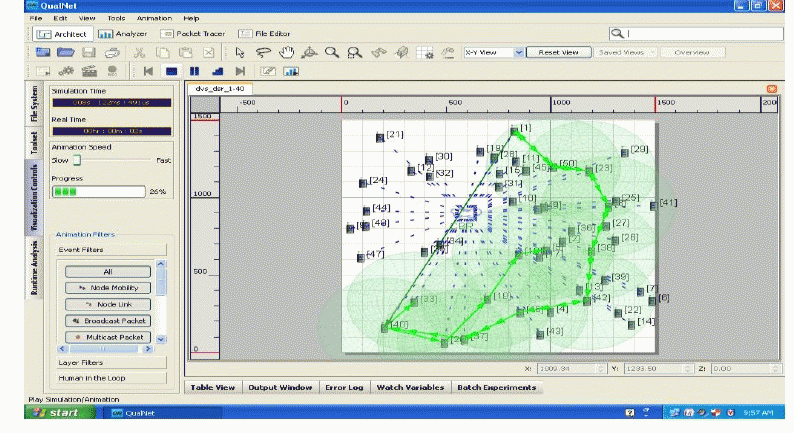 |
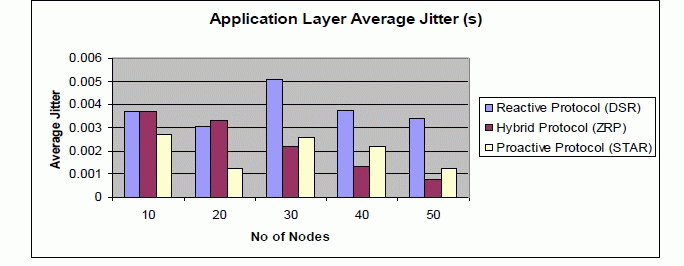 |
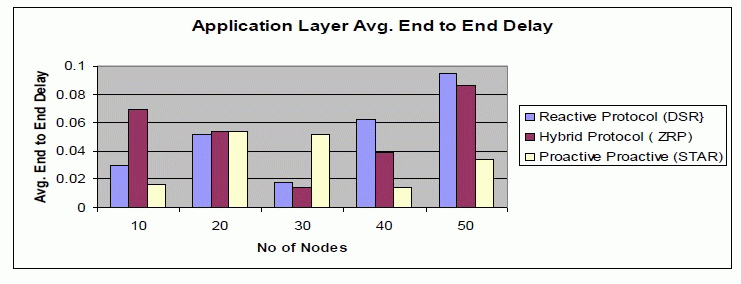 |
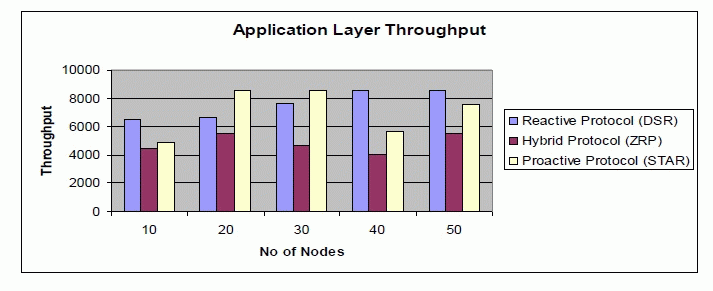 |
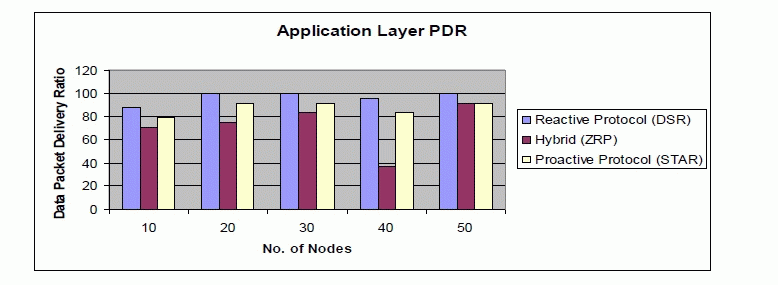 |
| Figure 1 |
Figure 2 |
Figure 3 |
Figure 4 |
Figure 5 |
 |
 |
 |
 |
| Figure 6 |
Figure 7 |
Figure 8 |
Figure 9 |
|
| |
References
|
- Juan-Carlos and Pietro Manzoni, “A Performance Comparison of Energy Consumption for Mobile Ad Hoc Network„s Routing Protocols”, inProceedings of the 2000 IEEE.page no. 57-63.
- Jun-Hoong and Au-Yong, “Comparison of On Demand Mobile Ad Hoc Network Routing protocols Under ON/OFF Source Traffic Effect”, Proc. OfIASTED International Conference, March 29-31, 2006, Chiang Mai, Thailand
- Ahmed Al-Maashri and M. Ould-Khaoua, “Performance Analysis of MANET Routing Protocols in the Presence of Self-Similar Traffic”, Proceeding31st IEEE Conference on Local Computer Networks, pp- 801-807, 2006.
- DhirajNitnaware and Ajay Verma, “Energy Evaluation of Proactive and Reactive Protocol for MANET Under ON/OFF Source Traffic”, Proceeding ofACM International Conference on advances in Computing, Communication and Control (ICAC3-2009), pp 451-455, Fr. Conceicao Rodrigues College ofEngg. Bandra, Mumbai, January 23-24, 2009.
- R.Kravets and P.Krishnan, “Power Management Techniques for Mobile Communications”, Proceedings of the ACM Mobile Computing and NetworkingConference, Dallas, Texas, October 1998, pages 157-168.
- A.K.Vatsa, Prince Chauhan, MeenakshiChauhan and Jyothi Sharma, “Routing Mechanism for MANET in Disaster Area”, International Journal ofNetworking and Mobile Technologies, Vol 2 / ISSUE 2/ MAY 2011.
- AnkitBhardwaj, Divya and SanjeevSofat, “An Efficient Energy Conserving Scheme for IEEE 802.11 ADHOC Networks”, IEEE 1-4244-1005-3/07,2007.
- DhirajNitanaware, Ajay Verma, “Energy Evaluation of Two on Demand Routing protocol Under Stochastic Traffic”, 978-1-4244-2746-8/08, 2008
- “Qualnet 5.0.1 userâÃâ¬ÃŸs Guide”, online. Available: http://www.scalablenetworks.com/.
- J. H Chang and L. Tassiulas, “Energy Conserving Routing in Wireless Ad-hoc Networks”, Proc. IEEE INFOCOM, Tel Aviv, Israel, Pages 22-31, March2000
- Juan Carlos Cano and Pietro Manzoni., ”A Performance Comparison of Energy Consumption for Mobile Ad Hoc Network Routing Protocols”,Proceeding of 8th International Symposium on Modeling, Analysis and Simulation of Computer & Telecommunication System 2000.
- SantashilPalChaudhuri and David B. Johnson, “Power Mode Scheduling for Ad Hoc Networks”, IEEE International Conference on Network Protocols,2002.
- K. Arulanandam and B. Parthasarathy, “A New Energy Level Efficiency Issues In MANET”, IJRIC, E-ISSN: 2076- 3336, 2009, pp.104-109,www.ijric.org.
- L. M. Feeney, “An Energy Consumption Model for Performance Analysis of Routing Protocols for Mobile Ad Hoc Networks”, Mobile Networks andApplications, Volume 6, Issue 3, June 2001, pages 239 - 249.
- M. Fotino, “Evaluating Energy Consumption of Proactive and Reactive Routing Protocols in a MANET”, Proc. 1st Int. Conf. On Wireless Sensor andActor Networks, Sept. 2007, pp. 119-130.
- NeerajTantubay, Dinesh RatanGautam and Mukesh Kumar Dhariwal, “A Review of Power Conservation in Wireless Mobile Adhoc Network(MANET)”, IJCSI, Vol.8 Issue 4, No 1, July 2011.
- Nikolaos A. Pantazis, and Dimitrios D. Vergados, “A Survey on Power Control Issues In Wireless Sensor Networks”, IEEE Communications Surveys &Tutorials, VOLUME 9, NO.4, 2007, pp.86-107, www.comsoc.org/pubs/surveys.
|